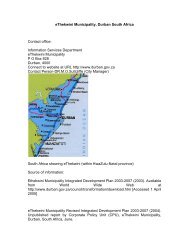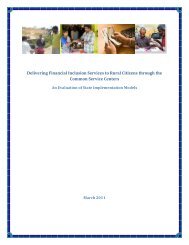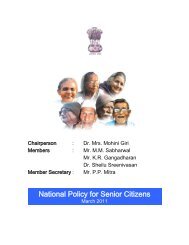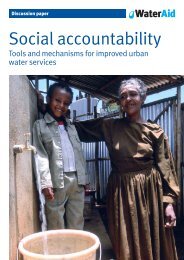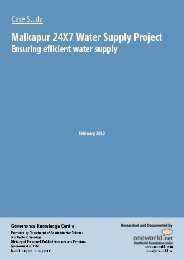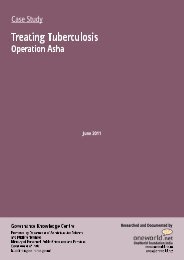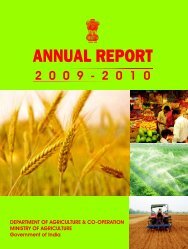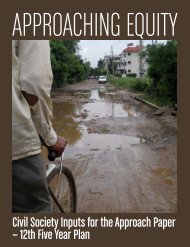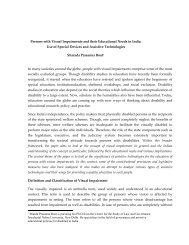See full case study - Indiagovernance.gov.in
See full case study - Indiagovernance.gov.in
See full case study - Indiagovernance.gov.in
Create successful ePaper yourself
Turn your PDF publications into a flip-book with our unique Google optimized e-Paper software.
Governance Knowledge CentrePromoted by Department of Adm<strong>in</strong>istrative Reforms and Public GrievancesM<strong>in</strong>istry of Personnel, Public Grievances and Pensions, Government of IndiaTransparency and AccountabilityCase StudyE-Governancee-MamtaMarch 2012Table of ContentsExecutive Summary .................................................................................................................................. 3Methodology ................................................................................................................................4Background ................................................................................................................................4Objective ................................................................................................................................5Programme Design ................................................................................................................................... 6Key Stakeholders............................................................................................................................................................. 6Work Flow ................................................................................................................................6Impact/Achievements ............................................................................................................................... 9Challenges <strong>in</strong> Implementation ................................................................................................12Conclusion ................................................................................................................................14References ................................................................................................................................152Researched and documented byOneWorld Foundation India
Governance Knowledge CentrePromoted by Department of Adm<strong>in</strong>istrative Reforms and Public GrievancesM<strong>in</strong>istry of Personnel, Public Grievances and Pensions, Government of IndiaTransparency and AccountabilityCase StudyE-Governancee-MamtaMarch 2012the basic premise aga<strong>in</strong>st which efforts to address the challenge of maternal and <strong>in</strong>fant deathswere to be mobilized. NHRM prescribed several measures to forward these goals. Thestrategies <strong>in</strong>cluded enhanc<strong>in</strong>g demand for health care (Janani Suraksha Yojana, a cash transferscheme, based on the condition of deliver<strong>in</strong>g <strong>in</strong> an <strong>in</strong>stitution), improv<strong>in</strong>g public sectorservices( pregnancy detection kits, skill attendants at birth, obstetric care, health facilities, safeabortion services and such), engag<strong>in</strong>g private partners( Chiranjeevi Yojna, Gujarat) and new<strong>in</strong>itiatives like Maternal Death Review and name based track<strong>in</strong>g systems for pregnant mothersand children.The state of Gujarat has <strong>in</strong>itiated ‘e-Mamta’, a ‘mother and child name-based <strong>in</strong>formationmanagement system. It has played a significant role <strong>in</strong> promot<strong>in</strong>g <strong>in</strong>stitutional delivery. ‘e-Mamta’, is <strong>in</strong>novative as it is designed to harness the benefits of ICT to improve effective andefficient delivery of health care services available. The programme has been designed to coverthe entire state of Gujarat and specifically caters to rural and urban slum communities. The<strong>in</strong>itiative was conceived by the State Rural Health Mission of the Health and Family WelfareDepartment, Gujarat, <strong>in</strong> January 2010 and was developed through the National InformaticsCentre (NIC). It is funded by NRHM.Objective‘e-Mamta’ can be viewed as an offshoot of the state’s commitment to the goals of safemotherhood and child survival. The <strong>in</strong>itiative aims at facilitat<strong>in</strong>g at<strong>in</strong>g this goal by develop<strong>in</strong>g a<strong>case</strong>-based track<strong>in</strong>g software that <strong>in</strong>tegrates all pregnant mothers and children as recipients ofprimary maternal and child health care services. The primary objective of the software is tomonitor the delivery of different health services and at the <strong>in</strong>dividual level. This will be basedon:i. Generat<strong>in</strong>g a valid and reliable database of the recipients and non recipients ofhealth services at the grass root level.ii.Enabl<strong>in</strong>g service providers (health workers and doctors) to effectively identifyand assist potential recipients of health services based on this auto generated listof beneficiaries.The ma<strong>in</strong> beneficiaries of the scheme <strong>in</strong>clude pregnant women, children (0-6 years) andadolescents (10-19 years).5Researched and documented byOneWorld Foundation India
Governance Knowledge CentrePromoted by Department of Adm<strong>in</strong>istrative Reforms and Public GrievancesM<strong>in</strong>istry of Personnel, Public Grievances and Pensions, Government of IndiaTransparency and AccountabilityCase StudyE-Governancee-MamtaMarch 2012The name-based track<strong>in</strong>g system identifies the beneficiaries and aims at secur<strong>in</strong>g the services ofante natal care (ANC), child birth, post natal care (PNC), immunization, nutrition, adolescentand family plann<strong>in</strong>g services to them.Programme DesignKey StakeholdersSERVICEPROVIDERS•STATE LEVELHealth and Family WelfareDepartment.National Informatics centre•INTERMEDIATE LEVELDistrict and Block officials•LOCAL LEVELDoctorsHealthWorkers(ANM/ASHA/FHW)SERVICERECIPIENTS•All eligible pregnant women(15-45 years)•Children(0-6 years)•Adolescents (10-19 years)Work FlowThe work<strong>in</strong>g of ‘e-Mamta’ can be classified <strong>in</strong>to four important phases;• Family Health SurveyThe family health survey facilitated the compilation of <strong>in</strong>dividual health records of 480million beneficiaries. The survey covered components like identification details(location, name, date of birth, caste, ration card, BPL card, RSBY card), health providerdetails (ANM, ASHA, Chiranjeevi yojna, private hospitals), ANC, pregnancy and PNCdetails for pregnant mother, child, adolescent and family plann<strong>in</strong>g.6Researched and documented byOneWorld Foundation India
Governance Knowledge CentrePromoted by Department of Adm<strong>in</strong>istrative Reforms and Public GrievancesM<strong>in</strong>istry of Personnel, Public Grievances and Pensions, Government of IndiaTransparency and AccountabilityCase StudyE-Governancee-MamtaMarch 2012The survey was conducted by local health workers and succeeded to cover 80% of thetotal population from both rural and urban (slum) areas. The data is updated everyyear.With the completion of the survey, the physical and cross verification of the data wasconducted to ensure its accuracy and validity. The physical verification of the data wasconducted by ASHA/ANM/FHW /HV and cross verification is led by district and blocklevel officials such as the MO/BHO/RCHO/ADHO/CDHO.• RegistrationPregnant women and children (0-6 years) once identified areregistered. They are provided a unique mother and childHealth Identity card.Family HealthSurvey• Work plan to track service deliveryHealth care services delivered to pregnant women andchildren are tracked through a unique system of work plans.The work plan is novel concept that has been <strong>in</strong>troduced <strong>in</strong>the public health for the first time through e-Mamta. Itconta<strong>in</strong>s relevant and accurate <strong>in</strong>formation for servicedelivery ery and track<strong>in</strong>g the non recipients of services.The work plans are prepared on a weekly or monthly basis bythe medical officer as per the requirements of the PHC. Theseare developed at the sub centres at the local level or e-gramkendras <strong>in</strong> the village. It enlists the services to be provided tothe beneficiaries <strong>in</strong>clud<strong>in</strong>g ANC, delivery, PNC andimmunization, nutrition and such. Moreover, it also assists <strong>in</strong>identify<strong>in</strong>g the gaps <strong>in</strong> the services availed by the recipients.RegistrationWork plans totrack servicesMonitor<strong>in</strong>gandEvaluationA copy of the work plan is distributed to the ANM/ASHA workers and additionalfemale health workers. The <strong>in</strong>formation helps them organise their rout<strong>in</strong>e visits, providenecessary services to the beneficiaries and effectively dissem<strong>in</strong>ate service related<strong>in</strong>formation.7Researched and documented byOneWorld Foundation India
Governance Knowledge CentrePromoted by Department of Adm<strong>in</strong>istrative Reforms and Public GrievancesM<strong>in</strong>istry of Personnel, Public Grievances and Pensions, Government of IndiaTransparency and AccountabilityCase StudyE-Governancee-MamtaMarch 2012• Monitor<strong>in</strong>g and EvaluationThe e-Mamta software facilitates effective monitor<strong>in</strong>g of the delivery of health services.Regular evaluations are conducted based on the <strong>in</strong>formation generated through thesystem. This <strong>in</strong>cludes;i. Child immunisation records, child growth charts (male and female) and otherreports. These records are available onl<strong>in</strong>e and at e-Sewa Kendra.ii. Monthly report formats, that conta<strong>in</strong> the aggregates of the services delivered tothe <strong>in</strong>dividual beneficiaries. On the basis of this <strong>in</strong>formation services fordifferent beneficiaries can be planned and tracked.iii. Identification details assist effective track<strong>in</strong>g of the migrated beneficiaries.family ID, health ID, name, ration card number, RSBY number, BPL number,mobile number, child’s date of birth are the few parameters that enable<strong>in</strong>dividual <strong>case</strong>-based track<strong>in</strong>g and identification.Moreover, through short message service alerts sent to the beneficiaries/fieldworkers/district and block level authorities, the monitor<strong>in</strong>g of services and its timelydelivery is facilitated effectively.Technology:The technological components can be classified under two;i. Software‘e-Mamta’ is a web based application that is developed <strong>in</strong> .Net technology withMS SQL 2005 database server. For local language <strong>in</strong>terface it uses Unicodecompliant Gujarati fonts and the SQL Report<strong>in</strong>g server enables datadissem<strong>in</strong>ation 22.ii. HardwareThe m<strong>in</strong>imal requirements of operat<strong>in</strong>g the system <strong>in</strong>clude a computer, <strong>in</strong>ternetconnectivity and a data entry operator.2E-Mamta: Name Based Mother and Child Track<strong>in</strong>g Application.Gujarat Informatics Limited. October-November 2010. Web. 26 March.2012. http://www.gujarat<strong>in</strong>formatics.com/pdf/E-Mamta.pdf8Researched and documented byOneWorld Foundation India
Governance Knowledge CentrePromoted by Department of Adm<strong>in</strong>istrative Reforms and Public GrievancesM<strong>in</strong>istry of Personnel, Public Grievances and Pensions, Government of IndiaTransparency and AccountabilityCase StudyE-Governancee-MamtaMarch 2012Tra<strong>in</strong><strong>in</strong>gThe tra<strong>in</strong><strong>in</strong>g of all implement<strong>in</strong>g agencies has been conducted at the state and the district levelsby the <strong>gov</strong>ernment of Gujarat. The stakeholders are tra<strong>in</strong>ed on different components of theprogramme.i. The state office conducts state level tra<strong>in</strong><strong>in</strong>g for super<strong>in</strong>tendents of all communityii.iii.health centres, chief district medical officer, Chief District health officer and urbanhealth officers.The state officials conduct regional level tra<strong>in</strong><strong>in</strong>g formembers of the district and block health teams <strong>in</strong>clud<strong>in</strong>gRCHO/ADHO/BHO/MO/BHV/BV.The regional health teams facilitate tra<strong>in</strong><strong>in</strong>g sessions for thegrassroots health workers.STATE LEVELTRAINING FORSTATE OFFICIALSMoreover, SATCOM or satellite communication network serviceshave been utilised to facilitate distant <strong>in</strong>teractions with medical andparamedical staff at the state, district and the block level. TheSATCOM programme is organised every month to review theimplementation process and provide necessary guidel<strong>in</strong>es.REGIONAL LEVELTRAINING FORDISTRICT ANDBLOCK OFFICIALSGRASSROOTTRAINING FORFIELD WORKERSImpact/AchievementsThe impact and achievements of the ‘e-Mamta’ <strong>in</strong>itiative has beensignificant. It has been able to accelerate the process of effective and efficient delivery of healthservices to the grass roots.7274Subcentres283CommunityHealthCentres26DistrictHospitals1090 PublicHealthCentres9Researched and documented byOneWorld Foundation India
Governance Knowledge CentrePromoted by Department of Adm<strong>in</strong>istrative Reforms and Public GrievancesM<strong>in</strong>istry of Personnel, Public Grievances and Pensions, Government of IndiaTransparency and AccountabilityCase StudyE-Governancee-MamtaMarch 2012The coverage of the <strong>in</strong>itiative extends to 7 corporations, 172 nagarpalikas and all villages of thestate of Gujarat. The high rate of expansion can be attributed to several factors:i. Monitor<strong>in</strong>g: The system enables effective grassroot monitor<strong>in</strong>g of health services. Thesystem generates multiple reports and records document<strong>in</strong>g public health utility. Suchas the follow<strong>in</strong>g;• Family Health Survey Data Entry Status• Family Health Survey Register 2• Mother Care Register No.4• Child Care Register No.5• Registration of Pregnant Women• Registration for Child Services• Pregnant Mother Summary• Child Summary (0-1 yrs & 1-6 yrs.) etc.• Registration of AdolescentThe database facilitates monitor<strong>in</strong>g of different services at the <strong>in</strong>dividual level based onthese reports that can be sorted by <strong>in</strong>dividual recipients, village, period, serviceproviders and such crucial parameters.Steps are be<strong>in</strong>g adopted to <strong>in</strong>tegrate this database <strong>in</strong>to the Hospital ManagementInformation System (HMIS) of the state of Gujarat. The HIMS has been developed tomonitor and control the function<strong>in</strong>g of hospitals to improve the health service deliverybased on an automated <strong>in</strong>formation system conta<strong>in</strong><strong>in</strong>g health records of the patients.ii.iii.iv.Stock Management:The programme has facilitated efficient stock management. Itensures stock monitor<strong>in</strong>g through entry of stock positions at each PHC. The entries onceupdated <strong>in</strong>to the system cannot be manipulated or changed. This has reduced <strong>in</strong>stancesof corruption and fraud.Information dissem<strong>in</strong>ation: The system has enabled <strong>in</strong>creased public access to crucialhealth related <strong>in</strong>formation. The database is available to all service providers andrecipients through a common source. It facilitates access to <strong>in</strong>formation on the servicesavailable, service providers, service recipients and non-recipients, records of thebeneficiaries of <strong>gov</strong>ernment schemes and related benefits, details about the <strong>in</strong>centivespaid to the health workers and such. The database ensures effective monitor<strong>in</strong>g andevaluation of primary health care facilities.Policy plann<strong>in</strong>g and management: Access to a comprehensive data set based on validdenom<strong>in</strong>ators has greatly benefited effective preparation of state/district/block level10Researched and documented byOneWorld Foundation India
Governance Knowledge CentrePromoted by Department of Adm<strong>in</strong>istrative Reforms and Public GrievancesM<strong>in</strong>istry of Personnel, Public Grievances and Pensions, Government of IndiaTransparency and AccountabilityCase StudyE-Governancee-MamtaMarch 2012health action plans. This <strong>in</strong>formation base enables detailed analysis of data <strong>in</strong> way thatfacilitates accurate identification of the gaps <strong>in</strong> service. It has enabled programmanagers to adopt a more focused approach to policy formulation on and plann<strong>in</strong>g.v. Effective Inter departmental communication: The process of effective policy plann<strong>in</strong>gand implementation is also supported by an effective system of <strong>in</strong>formationdissem<strong>in</strong>ation, put <strong>in</strong> place by e-Mamta. It replaces the traditional system based on acumbersome process of send<strong>in</strong>g the health data from sub centre to state centre. Theprocess consumed 25 days. With the help detailed work plans, the communicationamongst different implement<strong>in</strong>g agencies is more convenient as all the <strong>in</strong>formation isavailable at a s<strong>in</strong>gle po<strong>in</strong>t. S<strong>in</strong>ce the entire process is automated and ICT enabled,<strong>in</strong>formation dissem<strong>in</strong>ation takes very little time. The data can be accessed easilythrough GSWAN or <strong>in</strong>ternet connection (broadband/wi fi/data card) at any place andtime.vi.vii.A citizen-centric centric health delivery system: One of the primary objectives of the <strong>in</strong>itiativeis to <strong>in</strong>crease the beneficiaries of free primary health care services. Hence, identificationof the recipient and non recipients of the services and ensur<strong>in</strong>g timely delivery ofservices to the beneficiaries is a pre requisite. One of the major technologicaladvancement of the <strong>in</strong>itiative was activat<strong>in</strong>g a cell phone based system to expand itscoverage. Timely SMS alerts are sent to the beneficiaries, <strong>in</strong>form<strong>in</strong>g them about servicesto be availed. The <strong>in</strong>novative <strong>in</strong>tegration of mobile phone technology and public healthutility has helped enhance the citizen-centric centric character of the <strong>in</strong>itiative.Grassroot health workers as agents of change: The effective implementation of thesystem is dependent on the capacity of grassroot workers to deliver primary health carefacilities to a beneficiary’s door step. Lack of awareness, socio-economic constra<strong>in</strong>ts,illiteracy, poor medical <strong>in</strong>frastructure and medical aid at the local level are pert<strong>in</strong>entchallenges confront<strong>in</strong>g rural and urban slum areas. The grassroot health worker canplay a crucial role <strong>in</strong> l<strong>in</strong>k<strong>in</strong>g such communities to the primary health care. The ‘e-Mamta’ <strong>in</strong>itiative is cont<strong>in</strong>uously work<strong>in</strong>g towards creat<strong>in</strong>g a pool of tra<strong>in</strong>ed and skilledworkforce that can revive and <strong>in</strong>culcate a sense of responsibility towards good healthand wellbe<strong>in</strong>g and most importantly a commitment towards safe motherhood and childsurvival at the grassroots.11Researched and documented byOneWorld Foundation India
Governance Knowledge CentrePromoted by Department of Adm<strong>in</strong>istrative Reforms and Public GrievancesM<strong>in</strong>istry of Personnel, Public Grievances and Pensions, Government of IndiaTransparency and AccountabilityCase StudyE-Governancee-MamtaMarch 2012Challenges <strong>in</strong> ImplementationThe goal of realis<strong>in</strong>g an effective system of monitor<strong>in</strong>g public health service delivery isconstra<strong>in</strong>ed by several challenges.i. Develop<strong>in</strong>g a self susta<strong>in</strong><strong>in</strong>g <strong>in</strong>frastructure: ‘e-Mamta’ aims at address<strong>in</strong>g thechallenge of effective service delivery cover<strong>in</strong>g the entire state of Gujarat. It confronts amammoth challenge of <strong>in</strong>stitut<strong>in</strong>g self susta<strong>in</strong><strong>in</strong>g arrangements that can ensureimproved primary health care across the region. As a novel <strong>in</strong>itiative, the cont<strong>in</strong>uoussupply resources, workforce, tra<strong>in</strong><strong>in</strong>g, <strong>in</strong>frastructure has to be undertaken by the state<strong>gov</strong>ernment. Its <strong>in</strong>volvement needs to be ensured at every stage as the <strong>in</strong>itiative takesform. Coord<strong>in</strong>at<strong>in</strong>g between different agencies and <strong>in</strong>stitutions <strong>in</strong>volved <strong>in</strong> theprogramme and capacitat<strong>in</strong>g them to deliver effectively is an ongo<strong>in</strong>g task.Steps have been adopted to cope with the demands of promot<strong>in</strong>g the <strong>in</strong>itiative at a largescale. The <strong>gov</strong>ernment is cont<strong>in</strong>uously <strong>in</strong>volved <strong>in</strong> extend<strong>in</strong>g technical and manpowersupport <strong>in</strong> terms of commuters, data entry operators, network services at thedistrict/block t/block and local PHC level and build<strong>in</strong>g necessary <strong>in</strong>frastructure.ii.Accurate data entry:The system supports <strong>in</strong>dividual health records of 480 millionbeneficiaries. Ensur<strong>in</strong>g accuracy <strong>in</strong> generat<strong>in</strong>g <strong>in</strong>formation, verification and its entry<strong>in</strong>to the system’s database is a significant challenge. The <strong>gov</strong>ernment is try<strong>in</strong>g toaddress these issues by outsourc<strong>in</strong>g data entry functions.iii.Day to day hand hold<strong>in</strong>g and support: The responsibility of cater<strong>in</strong>g to the large scaledemand for effective delivery of health services is dependent on cont<strong>in</strong>uous supportand hand hold<strong>in</strong>g. The <strong>gov</strong>ernment was able to overcome this concern by activat<strong>in</strong>g a24X7 help desk.iv.Motivat<strong>in</strong>g field health worker: It has been challeng<strong>in</strong>g to develop a sense ofmotivation amongst the field health workers. A significant part of the <strong>in</strong>itiative is basedon the door to door <strong>in</strong>formation generation and dissem<strong>in</strong>ation concern<strong>in</strong>g primaryhealth care. Hence, the role of a field health worker was crucial for the effectiveoperation of the programme. Resistance and lack of commitment towards theirfunctions, apathy towards proper documentation and lack of adequate resources fordata ma<strong>in</strong>tenance may be identified as key constra<strong>in</strong>ts restrict<strong>in</strong>g active <strong>in</strong>volvement ofthe community health workers.However, cont<strong>in</strong>ued efforts have been made to <strong>in</strong>tegrate the local health workers <strong>in</strong>tothe scheme of the system. This was primarily ensured through regular tra<strong>in</strong><strong>in</strong>g,12Researched and documented byOneWorld Foundation India
Governance Knowledge CentrePromoted by Department of Adm<strong>in</strong>istrative Reforms and Public GrievancesM<strong>in</strong>istry of Personnel, Public Grievances and Pensions, Government of IndiaTransparency and AccountabilityCase StudyE-Governancee-MamtaMarch 2012sensitization programmes and workshops and reward<strong>in</strong>g and acknowledg<strong>in</strong>g theircontributions through <strong>in</strong>centives and awards.Moreover, the work plans have reduced a significant proportion of the manual workundertaken by the fieldworker. With the access to a comprehensive and detailed set ofdata <strong>in</strong> the form of a work plan, the field workers have been able to organise theirrout<strong>in</strong>e visits and effectively discharge their duties of <strong>in</strong>form<strong>in</strong>g beneficiaries about thehealth services that needed to be availed.v. Community ownership and participation: To secure <strong>in</strong>creased participation of thetargeted communities can cont<strong>in</strong>ue to rema<strong>in</strong> a major roadblock. Several factors mayrestrict their active <strong>in</strong>volvement <strong>in</strong> the <strong>in</strong>itiative such as high level of unawareness,illiteracy and resistance to change. For example, <strong>in</strong> most rural areas, women prefer todeliver at home based on traditional ional practices. This has been a primary reason for highrate of maternal mortality. It can be challeng<strong>in</strong>g to replace such traditional practices thathave been adopted for years and develop awareness about the need to access medicalassistance and care for safe motherhood. With help of ANM/ASHA workers, efforts arebe<strong>in</strong>g made to bridge these gaps and <strong>in</strong>tegrate more women from rural and urban(slum) areas <strong>in</strong>to primary health care system.vi.Infrastructure deficiencies: The ‘e-Mamta’ is an ICT enabled <strong>in</strong>itiative. To ensure itseffective implementation especially <strong>in</strong> areas which may not be technologicallyadvanced, can be posited as an operational limitation of the system. Restrictions <strong>in</strong> theform of connectivity and electricity supply <strong>in</strong> backward areas can severely constra<strong>in</strong> thesystem. While the system also functions <strong>in</strong> an offl<strong>in</strong>e mode, operat<strong>in</strong>g the software <strong>in</strong>this form may render data updat<strong>in</strong>g a major challenge.vii.Technological constra<strong>in</strong>ts: One of major highlights of the <strong>in</strong>itiative is the use of mobiletechnology to improve the delivery of health services. However, this can also constra<strong>in</strong>the goals of the programme <strong>in</strong> a significant way. The low end mobile phones used for<strong>in</strong>formation dissem<strong>in</strong>ation are not supported by the local script. Although messages aresent <strong>in</strong> local language, these are typed <strong>in</strong> English.Adequate steps have been taken to tra<strong>in</strong> local health workers <strong>in</strong> English and <strong>in</strong> mobilephone based <strong>in</strong>formation dissem<strong>in</strong>ation.13Researched and documented byOneWorld Foundation India
Governance Knowledge CentrePromoted by Department of Adm<strong>in</strong>istrative Reforms and Public GrievancesM<strong>in</strong>istry of Personnel, Public Grievances and Pensions, Government of IndiaTransparency and AccountabilityCase StudyE-Governancee-MamtaMarch 2012ConclusionGiven the successful implementation of the programme, the <strong>gov</strong>ernment of Gujarat is plann<strong>in</strong>gto expand its scope with<strong>in</strong> the state. It aims at <strong>in</strong>tegrat<strong>in</strong>g the system with a mobile basedtechnology, comb<strong>in</strong>e the programme with other national policies and <strong>in</strong>itiatives such as ICDS,primary education and school health, evolve a supply cha<strong>in</strong> management of vacc<strong>in</strong>es anddrugs, generate complete health records and <strong>in</strong>tegrate private sector providers and <strong>in</strong>stitutionsat the village level <strong>in</strong>clud<strong>in</strong>g e-Gram and e-Sewa.The achievements of the programme have also been recognised by other states. Severalmeasures have been adopted to replicate the model and <strong>in</strong>tensify its impact. With its success <strong>in</strong>Gujarat, NHRM is pilot<strong>in</strong>g the model <strong>in</strong> other states like Himachal Pradesh, Andhra Pradesh,Jammu and Kashmir, Jharkhand and Uttarakhand.Based on these efforts to deepen the impact of the <strong>in</strong>itiative <strong>in</strong> Gujarat and across the country,one can say that ‘e-Mamta’ has proven to be a successful <strong>in</strong>itiative. By secur<strong>in</strong>g an arrangementthat has achieved effective delivery of public health service with<strong>in</strong> a short period of time, the<strong>in</strong>itiative encourages the need to <strong>in</strong>novate and change.Research was carried out by OneWorld Foundation India (OWFI), Governance Knowledge Centre (GKC) team.Documentation was created by Research Associate, Annie V<strong>in</strong>centFor further <strong>in</strong>formation, please contact Naimur Rahman, Director, OWFI, at owsa@oneworld.net14Researched and documented byOneWorld Foundation India
Governance Knowledge CentrePromoted by Department of Adm<strong>in</strong>istrative Reforms and Public GrievancesM<strong>in</strong>istry of Personnel, Public Grievances and Pensions, Government of IndiaTransparency and AccountabilityCase StudyE-Governancee-MamtaMarch 2012ReferencesOffice of Registrar General India. ‘Maternal and Child Mortality and Total Fertility Rates’.Sample Registration System. 2011. Web. 8 March. 2012.E-Mamta Mother and Child Track<strong>in</strong>g System. Health and Family Welfare Department,Government of Gujarat. 10 March. 2012. Health and Family Welfare Department, Government of Gujarat. Web. 2012.Ourvibrantgujarat. ‘E-Mamta– Highlight of Healthcare e Sectoral Sem<strong>in</strong>ar’. 2010. Web. 12 March.2012. ‘E-mamta: Gujarat’s mobile tech helps reduce <strong>in</strong>fant and maternal mortality, to be adoptedacross the nation’. Economic Times. March 2012.Web. 26 March 2012.http://articles.economictimes.<strong>in</strong>diatimes.com/2012-03-22/news/31225271_1_e22/news/31225271_1_e-mamta-pregnantwomen-health-workersE-Mamta: Name Based Mother and Child Track<strong>in</strong>g Application. Gujarat Informatics Limited.October-November 2010. Web. 26 March.2012.http://www.gujarat<strong>in</strong>formatics.com/pdf/E-Mamta.pdfOffer<strong>in</strong>g Per<strong>in</strong>atal Referral Transport Services <strong>in</strong> Rural India, Toolkit. United Nation Children’sFund. 2010. Web. 25 March. 2012.http://www.unicef.org/<strong>in</strong>dia/Referral_Transport_book-F<strong>in</strong>al_PDF.pdfVarma, Arun.‘MDG: “Mother” Development Goal’. February 2011, Web. 25 March.2012.http://www.iimahd.ernet.<strong>in</strong>/e<strong>gov</strong>/ifip/arun-varma.htm15Researched and documented byOneWorld Foundation India




